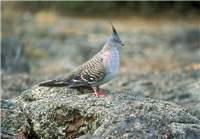Family
Columbidae
Genus
Ocyphaps
Species
lophotes
Threats/Control Methods - Regional
This species may cause a threat to other smaller seed eating birds through its dominance in this human-modified region. It may also spread the seeds of invasive weed grasses in areas where they are a problem.
Threats/Control Methods - Local
Free roaming domestic pets may harm young Crested Pigeons.
Local/Urban Actions
Gardeners are encouraged to remove any weed grass species and replace them with native grasses. This action can also be extended to revegetation work with a local Landcare group.
Common Names
Crested Pigeon, Topknot Pigeon, Crested Bronzewing
Distinguishing Features
The Crested Pigeon is named appropriately for the long, dark, fine pointed crest that sits upright on its grey head. It is 31-35cm in size, of mostly grey-brown plumage. A red ring surrounds the eyes; the legs are deep pink and the wings are touched with iridescent green and purple, black stripes and white tips.
Survey Techniques
Call and visual identification.
Species Call
A musical 'whoo' building to a strong 'whoo-whoo-whoo'.
Similar Species
The Rock Dove (Columba livia ) is another common pigeon species, however it lacks the distinctive crest.
Distribution
The Crested Pigeon is common over most of Australia's mainland.
Country of Origin
Australia
Conservation (Pet/Pest) Status - Regional
Numbers rose dramatically in past years in response to the clearing of thick vegetation and have now reached a fairly stable level.
Conservation (Pet/Pest) Status - National
Secure, not listed under the EPBC Act 1999.
LSCCES Population
Turner and Civic West had the highest number of birds, with no sightings at BMt, BMP or NMA.
Associated vegetation community
The species prefers semi-dry regions of lightly wooded grasslands near urban or rural areas. They are common to suburban gardens.
Limiting Resources
Crested Pigeons require a reliable water source in their fairly dry habitat and readily available grass seeds. The cleared environment of scattered trees for roosting and nesting is ideal.
Breeding
Males preform breeding displays almost all year round, while actual nest activity takes place from late September to late March. A nest of twigs is made in a thick shrub or tree. Both males and females care for their two eggs over 21 days of incubation and 21 days in the nest, with the number of dependant young peaking in December in the Canberra region.
Behaviour
The species is conspicuous for the whistling sound it makes while in flight. It is very approachable and is often seen perched on power lines in the suburbs, fanning its tail vertically. They are usually seen in groups of five or six, however they will congregate in large groups around waterholes.
Functional Group
Food Species
The Crested Pigeon feeds mostly on native or introduced grass seeds, although it will occasionally eat some leaves or insects. The birds feed in small to large groups and also come together to drink from waterholes in rural areas.
Predators
This common bird and its young are prone to attacks from European Red Foxes (Vulpes vulpes), Dogs (Canis familiaris) and Cats (Felis catus).
Interesting Fact
A whistling sound is produced when the Crested Pigeon is in flight by the air passing over a modified primary feather on the wing.
References - (reader suitability of references, P=Primary teachers, S=Secondary students, T=Tertiary students and researchers)
Books:Morcombe, M. 2000. Field Guide to Australian Birds. Steve Parish Publishing. Archerfield. Australia P, S, T
Pizzey, G. 2000. The Graham Pizzey & Frank Knight Field Guide to the Birds of Australia. Angus & Robertson, Sydney. P, S, T
Schodde, R. and Tideman, S. (eds) 1990. Reader's Digest Complete Book of Australian Birds (2nd Edition). Reader's Digest Services Pty Ltd. Sydney. P, S, T
Veerman, P. 2003. Canberra Birds: A report on the first 21 years of the garden bird survey. Philip Veerman and Canberra Ornithologists Group. Canberra. S, T
Internet: Birds in Backyards 2006. [online]. Available at:http://www.birdsinbackyards.net P, S, T
Canberra Ornithological Group (COG). 2004. Birds of Canberra Gardens. COG and the ACT Department of Urban Services. [online]. Available athttp://garden.canberrabirds.org.au/ P, S, T
Online Publications:Nix, H. and Cunningham, R. 2006. Birds of the Lower Sullivans Creek Catchment, Canberra ACT. Prepared for the Life in the Suburbs project using data from the Lower Sullivans Creek Catchment Ecological Survey (LSCCES). Australian National University. Canberra. [online]. Available at: http://www.lifeinthesuburbs.com.au/category.php?id=65 S, T

 Top
Top Top
Top